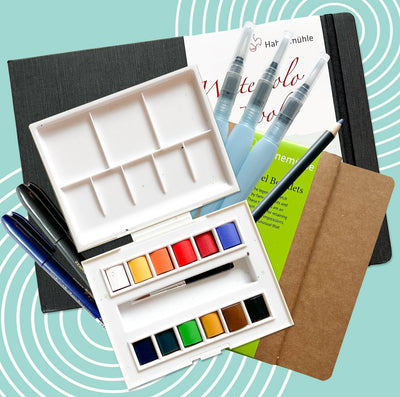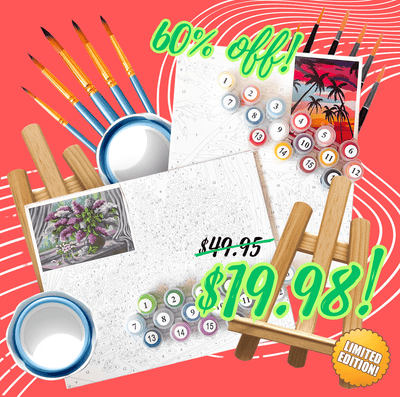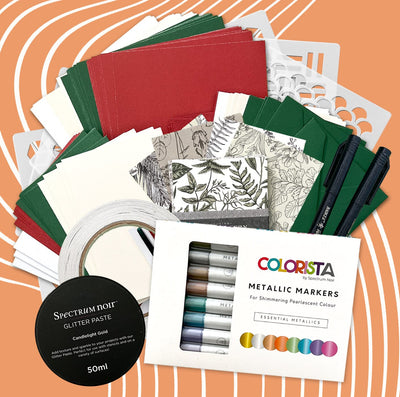Marbled paper is having an enthusiastic revival from makers and crafters all around the world. You've probably seen it on the cover of notebooks. Not to mention, similar techniques to water marbling are being used more and more frequently by calligraphers. But for an art whose wispy, pleasant patterns and resurfacing popularity feel like a breath of fresh air, it can be hard to believe that the techniques of marbling date back to the Middle Ages.

Marbled paper is the art of floating pigments and dyes on water, and transferring those patterns onto paper. The marbling artist uses the mobility of the water and suspended pigments to create free form shapes or combed patterns. The marbling artist can transfer patterns onto the same paper more than once, thus layering and deepening the marbled pattern.
Not only is marbling an old art, but it is also widespread. While the Suminagashi method of marbling was developing in Japan, a similar but separate form of marbling, called Ebru, was developing in Turkey.
Suminagashi

Suminagashi, meaning “floating ink,” is a method of marbling, developed in Japan. Suminagashi is an historical form of marbling paper that is still practiced today.
As it's name suggests, Suminagashi was made by dropping ink into water. Often, the impact from the ink droplet would spread out in a circle. The artist would then drop another drop of ink into the center of the spread circle. As that ink also spread, he might drop another. The original Suminagashi style took its form from concentric circles that flow and shape with disturbances in the water.
The artist would then manipulate the pattern by blowing across the surface of the water, using his breath or a fan. The fan method gives the pattern a smoky look. The artist might use hair on the surface of the water to trail the pattern and manipulate the flow of the circles.
In the 19th Century an exemplary artist of Suminagashi from Kyoto named Tokutaro Yagi developed a new way of changing the Suminagashi patterns. He dragged bamboo rods through the ink circles. This tool gave him more control over his art.
Ebru

In the Middle Ages in Turkey, a form of marbled paper called Ebru was developing. Ebru means “Cloud art.” Ebru frequently uses brighter pigments than the inks involved in Suminagashi. Ebru artists also used sticks or combs to drag the pigments in the water. This allows the artist to make a wide variety of patterns, including swirls and criss-crosses.
The Medieval European crusaders carried the techniques of Ebru to Europe from Turkey. These techniques became a staple in Continental European trade art throughout Early Modern history and the Renaissance. Frequently, English bookbinders, who did not receive the secret of how to marble paper from the Turkish, bought marbled papers from continental Europe.
Marbling Artists

It may seem strange that while marbling paper is one of the oldest and most iconic ways that artists have used pigments, marbling artists themselves tend to be low profile in the art world. This is especially strange when speaking about Renaissance art, because the Renaissance is characterized by high profile artists and patrons. It is possible that beauty of the marbled paper and the artist behind these papers remained understated, because the original uses of marbled paper were practical as well as aesthetic.
In Europe the art of marbling went hand in hand with the art of bookbinding. Marbling was an aesthetic way to protect documents from forgery. Books that featured marbled motifs on the edges of their papers were thought to be secure, because removing any of the pages would disturb the pattern. In this case, much of the Renaissance book art that involved beautiful marbled paper was primarily practical.
But while these artisans kept a low profile, they developed guilds in the early modern world and taught apprentices. Interest in the mysterious art of marbling was so rampant that both English and French authors felt the need to include it in Enlightenment era encyclopedias. Particularly Diderot wrote about the work of the marbler in his l'Encyclopedie. With his explanation, he provided an illustration of the marbling artist's tools and workspace.
Even though it is difficult to trace particular famous marbling artists through the Renaissance, it is possible to trace cultural trends. Just as Suminagashi takes a distinct form from Ebru, Venetian and Italian marbled papers takes on a different flavor and aspect from marbled paper of France. French paper marbling preferred a “curl” technique, where the marbling artist used a rod to spiral the paint into a central point. Venetian artists, on the other hand, were famous for their peacock patterns, which resembled the plumage of a peacock tail.
In 1853, Charles Woolnough demystified marbled paper by writing a how-to book called The Art of Marbling. While previous books discussed what the paper marbler did and what his work space looked like, Woolnough actually explained how to do it. This included the more obscure parts of marbling, such as what the paints were made of, and what ingredients were needed to allow the paints to float and to stick to the paper.
Woolnough's writing allowed the art of marbling to become even more widespread. And because of this, we have still been able to keep the art alive today. Even today, plenty of printing businesses and individual artists continue to hand marble paper. Some of these pieces become frame-worthy, independent pieces of art. Others are still sold for the art of book-binding, which is also undergoing a revival among makers and crafters.
Marbled paper would not be nearly so beautiful if individual artists did not take the initiative to develop their own techniques and take control of their painting. What sort of techniques and designs do you find most appealing in marbled paper?


